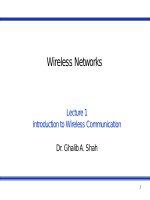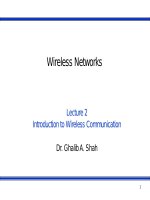Wireless networks - Lecture 24: CDMA2000
Bạn đang xem bản rút gọn của tài liệu. Xem và tải ngay bản đầy đủ của tài liệu tại đây (444.74 KB, 22 trang )
Wireless Networks
Lecture 24
CDMA2000
Dr. Ghalib A. Shah
1
Outlines
Last lecture review
Cdma2000 introduction
New MAC and Physical layer features
Physical layer of cdma2000
Reverse Physical channels
New Network elements in cdma2000
► Packet Control Function (PCF)
► Packet Data Serving Node (PDSN)
Mobility Management
Handoff
► Intra-PCF
► Inter-PCF/Intra-PDSN
► Inter-PDSN
2
Last Lecture review
Compressed mode measurements
Handover measurements
► Intra-mode
► Inter-mode
► Inter-system
WCDMA packet data access
Transport channels for packet data
► Common, dedicated, shared
Packet scheduling algorithms
► Time division scheduling
► Code division scheduling
► Transmission Power-based scheduling
3
CDMA2000 Introduction
Provides seamless and evolutionary upgrade path for
2G and 2.5G cdma technology.
Centers on original 1.25 MHz radio channel
CDMA operators may seamlessly and selectively
upgrade without changing entire BS equipment
The first 3G cdma standard cdma2000 1xRTT using
single channel (1x =>multi-carrier)
Cdma2000 1x
► Supports data rate up to 307 kbps in packet mode
► Can support up to twice as many users as 2G cdma
► Cdma 1xEV-DO dedicates the channel strictly to data user and
support 2.4 Mbps per channel.
4
cdma2000
Cdma2000 3xRTT
► The ultimate 3G solution relies upon multicarrier that
gang adjacent channels together into 3.75 MHz.
► Three non-adjacent channels may be operated
simultaneously and in parallel.
► Data rate in excess of 2 Mbps similar when
compared to W-CDMA
Advocates of cdma2000 claim their standard
much more seamless and less expensive
upgrade path when compared to W-CDMA.
5
WCDMA vs. CDMA2000
Parameter
WCDMA
cdma2000
Carrier spacing
5 MHz
3.75 MHz
Chip rate
4.096 MHz
3.6864 MHz
Data modulation
BPSK
FW – QPSK; RV BPSK
Spreading
Complex (OQPSK)
Complex (OQPSK)
Power control frequency
1500 Hz
800 Hz
Variable data rate implement.
Variable SF; multi code
Repet., puncturing, multi code
Frame duration
10 ms
20 ms (also 5, 30, 40)
Coding
Turbo and convolutional
Turbo and convolutional
Base stations synchronized?
Asynchronous
Synchronous
Base station acquisition/detect
3 step; slot, frame, code
Time shifted PN correlation
Forward link pilot
TDM dedicated pilot
CDM common pilot
Antenna beam forming
TDM dedicated pilot
Auxiliary pilot
6
The new physical and MAC layer features and
techniques
► Link adaptation based on adaptive modulation,
coding and spreading
► Physical layer fast hybrid ARQ
► Enhanced channel coding and turbo codes
► Space and antenna diversity
► Fast forward link power control and coherent uplink
demodulation
7
Physical Layer
The cdma2000 air interface is designed to provide
flexible framework for supporting voice and other
circuit-switched data as well as bursty packet data
bearer services with different QoS
cdma2000 supports RF channel band width of SRx1.25
MHz. currently SR 1 and 3 are supported and can be
extended to 6, 9 and 12.
A number of fixed and variable rate physical channels
are defined with new variable-length spreading codes
and PN codes.
The data rate, channel encoding and modulation
parameters are specified by radio configurations (RCs)
► For SR 1 and 3, there are 7 RCs for reverse link and 9 for
forward link
8
S R Fo rw ard
RC
Data Rate (Bas e , Re v e rs e
Pe ak)
RC
Data Rate (Bas e ,
SR
1
RC1
9.6
RC1
9.6
RC2
14.4
RC2
14.4
RC3
9.6, 153.6
RC3
9.6, 307.2
RC4
9.6, 307.2
RC5
14.4, 230.4
RC4
14.4, 230.4
RC6
9.6, 307.2
RC5
9.6, 614.4
RC7
9.6, 614.4
RC8
14.4, 460.8
RC6
14.4, 1036.8
RC9
14.4, 1036.8
SR
3
Pe ak)
RC1 and RC2 are similar to Rate Set 1 and 2 in IS-95
RCs are chosen such that base rate for a forward and a reverse link match. If RC3 is
used on reverse link, either RC3 or RC4 can be used on forward
9
Reverse Physical Channel
Channel Type
Max Max
SR1 SR3
Common Channel
Reverse Pilot channel
1
1
Un-modulated SS signal by each MS, BS detect corresponding
Uplink channel
Reverse Access Channel
1
NA
For backward compatibility, used for uplink common control
signaling
Reverse Enhanced Access
Channel
1
1
New channel used by MS to initiate communicate or respond to
BS when no dedicated channel is assigned to user
Reverse Common Control
Channel
1
1
Common channel used for short burst data and signaling
messages when traffic channels are not in use
Dedicated Channel
Reverse Dedicated Control
Channel
1
1
As before
Reverse Fundamental Channel
1
1
Basic traffic channel that carries voice, low-rate data and
associated signaling messages
Reverse Supplemental Code
Channel
7
NA
Fixed rate data only channel to provide higher transmission rate
Reverse Supplemental
Channel
2
2
Variable rate packet data channel carrying only high speed
coded info
10
Legacy cdmaOne Network
Designed to support voice and low-rate circuit-switched traffic
IS-95
VLR
AC
BTS
EIR
A Ref (A1, A2, A5)
MS
BSC
A-bis
BTS
HLR
STM over T1/T3 or
Ater Ref (A3, A7)
AAL1 over SONET
IS-95
A Ref (A1, A2, A5)
MSC
BTS
MS
BSC
A-bis
SMSSC
11
PSTN
New Network elements in CDMA2000
Legacy IS-95 A/B
A1 (S)
AAA
HA
MSC
A2 (UT)
MSC
A5 (UT)
IP Core
Network
PSTN
BTS
MS
BSC
A-bis
A3 (UT)
BTS
A3 (US)
A7 (S)
A8 (UT)
R-P
A9 (US)
MSC
PCF
MSC
PDSN/FA
BTS
MS
BSC
A-bis
BTS
12
MS: additional features to support data services and
enhanced signaling messages to both circuit-switched
and packet-switched
BS (BTS & BSC): enhanced radio interface (significant
hardware and software changes) to provide voice, data
and multimedia traffic support
Packet Control Function (PCF):
► an entity that manages the buffering and relay the packets
between BS and PDSN
► Maintain radio resource status (e.g. active, dormant)
► Collects radio link related accounting info to be used by AAA.
13
Packet Data Serving Node (PDSN): new network entity
► Acting as a FA by providing routing services (maintaining
routing tables and route discovery) according to Mobile IP
► Managing the radio-packet (R-P) interface and PPP sessions
for MS
► Initiating authentication, authorization and accounting for
mobile user to the AAA server
► When part of VPN, it can establish a tunnel through the public
data network using layer 2 tunneling protocol (L2TP) to the
VPN gateway.
► PDSN may optionally use IPSec protocol to further protect the
tunnel
14
Home Agent
► Network element within mobile’s home network
► Two major functions: mobile IP registration and
packet forwarding
► HA interacts with AAA to receive mobile IP
registration requests that have been authenticated
and return registration response
► HA also forwards IP packets to and from current
point of attachment through FA
15
AAA
► Authentication: verification of devices and subscribers for
network access as well as user-based QoS requests
► Authorization: whether a user or device is authorized for
particular service with a specific QoS based on service profile.
The requesting entity may cache the authorization info making
further decision itself without going to AAA.
► Accounting: involves collecting and storing billing-related data
concerning the offered services. It includes session details
(requested and offered QoS, duration of usage etc) and
mobility records (dates and times of attach and detach etc)
16
Mobility management for packet data services
When an MS originates a call
► Messages are exchanged to establish and close an
R-P connection between PCF/BSC and PDSN
► Once serial connection established between MS and
PDSN
• MS and PDSN negotiate authentication protocol according
to a challenge handshake authentication protocol (CHAP)
or a password authentication protocol (PAP)
• PDSN sends authentication response to AAA server, which
decide to authenticate or not
• PDSN constructs a network access identifier (NAI) of the
form MSID@realm (realm of the home network)
• The user is identified as a valid user and PDSN also knows
which IP service template to apply to this subscriber
17
► When PPP session is established, PDSN assigns
the mobile an IP address from a pool of IP
addresses
► The routers in the packet network must be able to
route any packet with this IP to the PDSN that
provides service to the mobile
18
Handoff
Intra-PCF
► Supported by A8/A9 interfaces carrying user traffic and
signaling between BS and PCF
Inter-PCF and Intra-PDSN
► On location change, must occur when causes to divert the
packet data session from one R-P interface to another
► New R-P connection between target PCF and serving PDSN is
established and PPP session will be moved to this
► Previous R-P session tear down
► PCF-PCF handoff may occur while MS is in active or dormant
state
► Dormant handoff is supported to maintain PPP session, where
a MS is dormant to minimize the use of air-link resources.
► During active session, PDSN supports low-latency handoff by
bi-casting data to the target and previous PCF19
Inter-PDSN
► A network based on simple IP does not support
mobility beyond a PDSN coverage area because
• New IP will be acquired from new PDSN and traffic on
existing IP will be undeliverable.
• Needs to support fast handoff i.e. Mobile IP
20
Inter-PSDN Fast Handoff
► The target PDSN initiates establishment of a P-P
session with the serving PDSN.
► P-P interface is used to keep PPP session anchored
when PDSN to PDSN handoff is performed allowing
existing PPP session to continue and reducing
service interruption time and data loss
21
Summary
Cdma2000 introduction
New MAC and Physical layer features
Physical layer of cdma2000
Reverse Physical channels
New Network elements in cdma2000
► Packet Control Function (PCF)
► Packet Data Serving Node (PDSN)
Mobility Management
Handoff
► Intera-PCF
► Inter-PCF/Intra-PDSN
► Inter-PDSN
22









